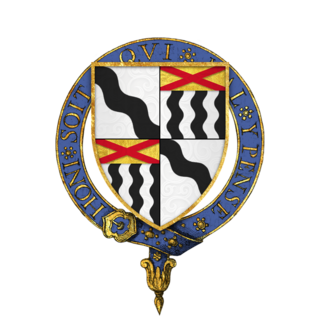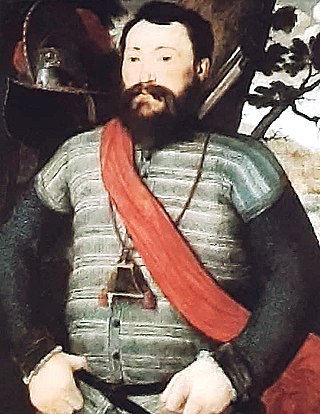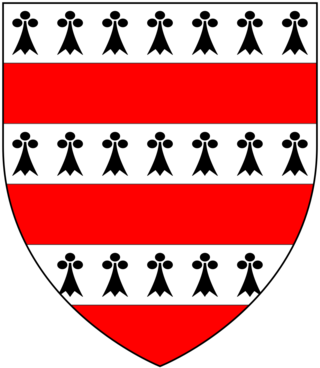
Stefan von Haschenperg was a military engineer employed by Henry VIII of England in the 1540s.

Stefan von Haschenperg was a military engineer employed by Henry VIII of England in the 1540s.
Very little is known of Stefan's career, however he was mentioned as a gentleman of Moravia, and subject of Bohemia, in a letter from the Regent of the Netherlands to Henry VIII in 1544. [1] He spoke in Polish to sailors of a fleet of Charles V in 1539. [2] He seems to have first offered his services as armourer and architect to Henry VIII in 1535; giving a note to the Duke of Suffolk to pass to Thomas Cromwell and the King. [3]
Stefan was part of the design team for the Device Forts at Sandgate and Camber Castles, and the gun emplacements made of earth on the Downs. In November 1540 he went to the Pale of Calais. The French ambassador in London, Charles de Marillac, heard of this and reported to Francis I of France that the "German" engineer had gone to design new bulwarks. Stefan "the Almain" crossed the border into Ardres for a day to spy out the French fortification there for Henry VIII. [4] However, Stefan was not fully trusted by the Privy Council, who instructed Henry FitzAlan, the Deputy of Calais, that "in no wise they should suffer him to view the town of Calais or to see the secrets of the same." [5]
In 1541, Stefan was directing work on new fortifications at Carlisle, and after a dispute with Thomas Gower, he was promoted to sole surveyor of the works. [6] He was sacked by the Privy Council two years later for having, "lewdlye behaved himself," and spent a great treasure to no purpose. [7] Stefan may have been the military engineer mentioned by Eustace Chapuys as returning to the Scottish border in January 1542 after having planned and commenced a line of defences. [8] On 17 July 1543 Stefan came before the Privy Council at Oatlands Palace and was reminded of his promise to make recompense for any faults. [9]
Stefan then went abroad. On 20 August 1544 Stefan contacted the English ambassador in Brussels, Sir Edward Carne. He offered information on Scottish recruiters who were looking for military experts for the war with England. Stefan said the Scots had made an offer to the uncle of Hans, a German plumber working at Hull, and he hoped Carne would write to Henry VIII in his favour if he found out more information. [10] Stefan then went to Antwerp and Lübeck, and wrote to Henry VIII in 1545, asking for his old job back. He suggested a scheme for bringing fresh water to Nonsuch Palace. [11] The last letter included a woodcut picture of a coin; and another of a combined horse and windmill, titled, "Eine wunderlicte roswintmulle, Emden, 1545". Stefan offered new chemical discoveries and the design of a water pumping mill;
Stefan said he would have tried out the last idea at his own house in England. He probably meant St Thomas's Mills at Stratford, London, which Henry had given him, then taken away in 1544. [13] Stefan seems not to have found work, but he did come back to England. On 9 January 1547, the Imperial ambassador in London, François van der Delft, wrote to Mary of Austria to ask what he should do about Haschenperg. Stefan and his wife had come to London thinking that Mary's letters would get his job back. Van der Delft suggested he should not intercede between Henry VIII and his servant. [14] Stefan then became a steward of Jan Dubravius, Bishop of Olmütz, in Bohemia. [15] The Bishop subsequently wrote a treatise on the construction of fish ponds.
Despite the circumstances of Stefan's dismissal from English royal service, and the shortcomings of some his buildings, B. H. St. J. O'Neil found it likely that his presence in the royal works account for some of features of the Henrician forts that correspond most closely to models proposed by Albrecht Dürer. [16]

At Camber, Stefan appears in the accounts for the second phase of work in 1539 and 1540 as a frequent visitor; "Master Stevyn the devysour". There was accommodation for him on site in the "Devisour's Chamber". In these works Haschenperg used flammable pitch to seal basement floors and even some of the roofs. His additions were quickly altered by subsequent works. Martin Biddle characterised his work as, "horrifyingly over-complex in its internal circulation, the result presumably of a wish to divide the castle into self-contained sectors in the event of enemy penetration", and added that Camber phase II and Sandgate are naive in comparison with Walmer, Sandown, and Deal Castles. Haschenperg constructed the earthen gun emplacements on the Downs between the latter castles. [19]
Stefan worked at Sandgate Castle at the same time as Camber, and signed the accounts, though he was not always present. Haschenperg disagreed with other officials over the roofing materials. [20] Stefan preferred tar and pitch for roofing rather than the more obvious choice of less flammable lead. [21]
In November 1540 Stefan was sent to help site artillery emplacements in the Calais marshes. As a foreigner he was not wholly trusted and his colleagues were asked not to let him view the secrets of the town. Stefan produced a map and subsequently six bulwarks were built as part of a larger project devised by Henry VIII. They were called; Hooke's, Crabbar's, Bootes, Ballingham , and Andren bulwarks. [22]
Stefan joined the work at Carlisle on 4 June 1541 in joint authority with Thomas Gower. He immediately complained to the Privy Council about the mismanagement of the works and the behaviour of Sir Thomas Wentworth, Captain of the Castle. The Council found for Stefan, and Gower was sent to Berwick. Over the next year and a half, £5000 was spent. Stefan lowered and strengthened the old castle keep to make it an artillery platform. New work included the half-moon battery which covered the inner bailey, and two small bulwarks or caponiers in the outer moat. Then the medieval Botcher gate in the town wall was replaced by the fortress called Carlisle Citadel. On 1 December 1542, Stefan was called to London and asked to bring the plans of next year's works. At the same time, Thomas Wharton and the Bishop of Carlisle were asked to view and report on his proceedings at Carlisle. [23] With accusations of mismanagement, before the works were completed, on 17 July 1543, the Privy Council recalled his promise to recompense the king for any wasted resources and asked him to make sureties for payment;
"Steven, Allemaigne, having hadde charge long tyme off certeyne off the Kinges Highnes' buyldinges and fortifications, for as muche as itt appered he hadde lewedlye behaved himselff in the sayde charge, and hadde spent the King a great tresour, and all to no purpose, ... was this day called before the Cownsell." [24]
By 17 November 1543, the Privy council ordered that Stefan was to be replaced by John Rogers and a new Clerk of works. [25] His English career was over. [26]
Stefan's design for the citadel at Carlisle was criticised by Francis Knollys in June 1569. He thought its three artillery platforms were vulnerable to attack because "it flanketh not itselffe very well, ... and the cownter skarffe serveth to cover the approach of the enemies." The platforms for mounting the guns were made of timber and decayed, so Knollys suggested filling the masonry walls with earth. He estimated the scrap value of the lead recovered from the platform would leave a profit of £200. [27]

Thomas Wriothesley, 1st Earl of Southampton, KG was an English peer, secretary of state, Lord Chancellor and Lord High Admiral. A naturally skilled but unscrupulous and devious politician who changed with the times, Wriothesley served as a loyal instrument of King Henry VIII in the latter's break with the Catholic church. Richly rewarded with royal gains from the Dissolution of the Monasteries, he nevertheless prosecuted Calvinists and other Protestants when political winds changed.

The Device Forts, also known as Henrician castles and blockhouses, were a series of artillery fortifications built to defend the coast of England and Wales by Henry VIII. Traditionally, the Crown had left coastal defences in the hands of local lords and communities but the threat of French and Spanish invasion led the King to issue an order, called a "device", for a major programme of work between 1539 and 1547. The fortifications ranged from large stone castles positioned to protect the Downs anchorage in Kent, to small blockhouses overlooking the entrance to Milford Haven in Pembrokeshire, and earthwork bulwarks along the Essex coast. Some forts operated independently, others were designed to be mutually reinforcing. The Device programme was hugely expensive, costing a total of £376,000 ; much of this was raised from the proceeds of the Dissolution of the Monasteries a few years before.

The First Siege of Boulogne took place from 19 July to 14 September 1544 and the Second Siege of Boulogne took place in October 1544.
Sir Thomas Wharton, 1st Baron Wharton was an English nobleman and a follower of King Henry VIII of England. He is best known for his victory at Solway Moss on 24 November 1542 for which he was given a barony.

Edward Fiennes, or Clinton, 1st Earl of Lincoln KG was an English landowner, peer, and Lord High Admiral. He rendered valuable service to four of the Tudor monarchs.

Sir John Wallop, KG was an English soldier and diplomat who belonged to an old Hampshire family from the village of Farleigh Wallop.
Sir Richard Lee (1513–1575) was a military engineer in the service of Henry VIII of England, Edward VI and Elizabeth I. He was a commander of Henry VIII and appointed surveyor of the King's works. Lee was member of parliament for Hertfordshire in 1545. He was the first English engineer to be knighted.

William FitzWilliam, 1st Earl of Southampton, KG, English courtier and soldier, was the third son of Sir Thomas FitzWilliam of Aldwark and Lady Lucy Neville, daughter of John Neville, 1st Marquess of Montagu.

William Sandys, 1st Baron Sandys, KG, of The Vyne in the parish of Sherborne St John, Hampshire, was an English diplomat, and a favourite of King Henry VIII, whom he served as Lord Chamberlain. In the 1520s he built a palatial Tudor-style mansion at "The Vyne", which survives in a reduced and classicised form as a possession of the National Trust.
Berwick Pursuivant of Arms in Ordinary was an English office of arms created around 1460 for service on the Scottish Marches based at Berwick-upon-Tweed. In the 16th century there was also a Herald or Pursuivant based at Carlisle on the west border.

Gregory Cromwell, 1st Baron Cromwell, KB was an English nobleman. He was the only son of the Tudor statesman Thomas Cromwell, 1st Earl of Essex and Elizabeth Wyckes.
Katharine Basset was an English gentlewoman who served at the court of King Henry VIII, namely in the household of Queen Anne of Cleves, and was briefly jailed for speaking against him. Three of her letters to her mother Honor Grenville survive in the Lisle Papers.

Sir Richard Weston (1465–1541), KB, of Sutton Place in the parish of Guildford in Surrey, was a courtier and diplomat who served as Governor of Guernsey, Treasurer of Calais and Under-Treasurer of the Exchequer during the reign of King Henry VIII.

Vice-Admiral Thomas Wyndham (1508–1554), also spelled as Thomas Windham, was an English naval officer, naval administrator, explorer, and navigator. He was appointed a member of the Council of the Marine as one of the Chief Officers of the Admiralty in 1552 and given the title of Master of Naval Ordnance and was simultaneously a member of the Board of Ordnance until 1553.

Sir Andrew Dudley, KG was an English soldier, courtier, and diplomat. A younger brother of John Dudley, 1st Duke of Northumberland, he served in Henry VIII's navy and obtained court offices under Edward VI. In 1547–1548 he acted as admiral of the fleet and participated in the War of the Rough Wooing in Scotland, where he commanded the English garrison of Broughty Castle. He was appointed captain of the fortress of Guînes in the Pale of Calais in late 1551. There he got involved in a dispute with the Lord Deputy of Calais, which ended only when both men were replaced in October 1552.
The Inventory of Henry VIII compiled in 1547 is a list of the possessions of the crown, now in the British Library as Harley MS 1419.

William Eure, 1st Baron Eure (c.1483–1548) of Witton was an English knight and soldier active on the Anglo-Scottish border. Henry VIII of England made him Baron Eure by patent in 1544. The surname is often written as "Evers". William was Governor of Berwick upon Tweed in 1539, Commander in the North in 1542, Warden of the Eastern March, and High Sheriff of Durham. During the Anglo-Scottish war called the Rough Wooing, Eure and his sons Henry and Ralph made numerous raids against towns and farms in the Scottish Borders.
Sir Edward Wotton (1489–1551) was the Treasurer of Calais and a privy councillor to Edward VI of England.

John Husee was a London merchant, and the business agent in England of Arthur Plantagenet, 1st Viscount Lisle (d.1542), during Lisle's absence abroad whilst serving as Governor of Calais during the years 1533 to 1540. Lord Lisle's correspondence was seized by the state when he was arrested in May 1540 for treason and heresy, and as a result, 515 letters written by Husee between 1533 and 1540 to Lord and Lady Lisle survive, mainly now preserved amongst the State Papers held at the National Archives. They were transcribed into modern English and in 1981 published, together with all the other Lisle Papers, by Muriel St Clare Byrne in her six-volume work "The Lisle Letters".
Peter Meutas or Mewtas, or Mewtis, or Meautis, or Meautys was an English courtier and soldier.